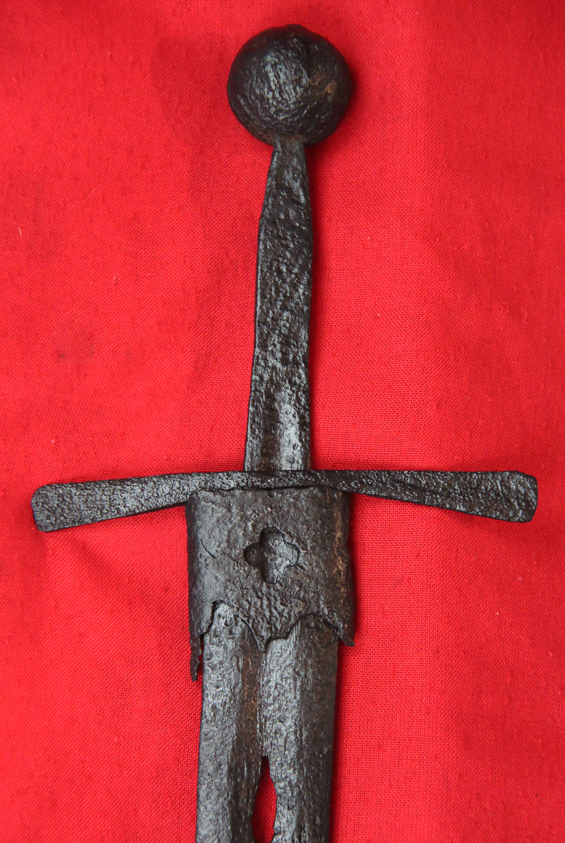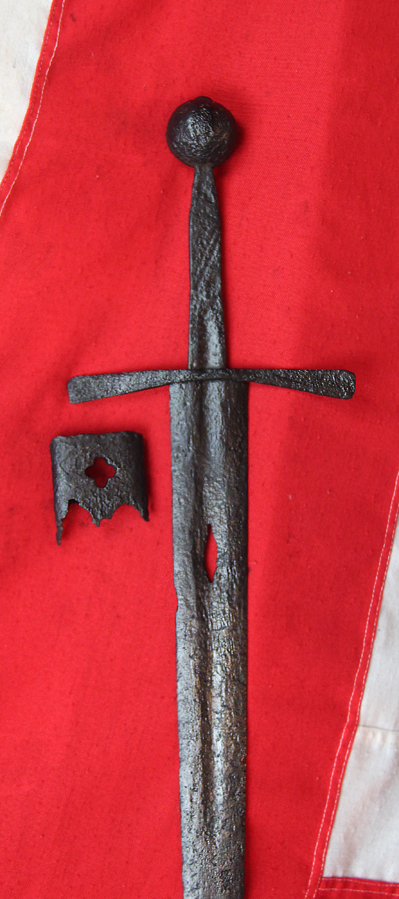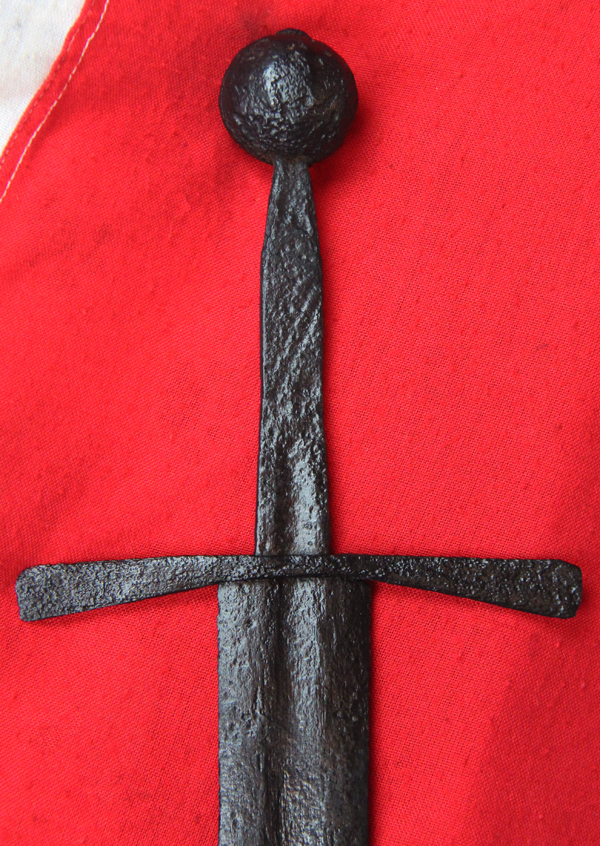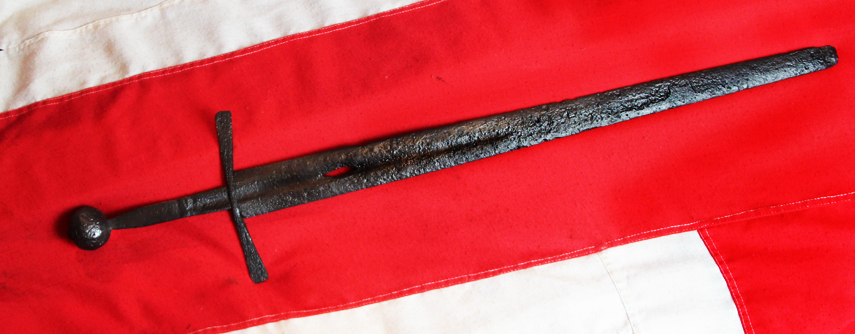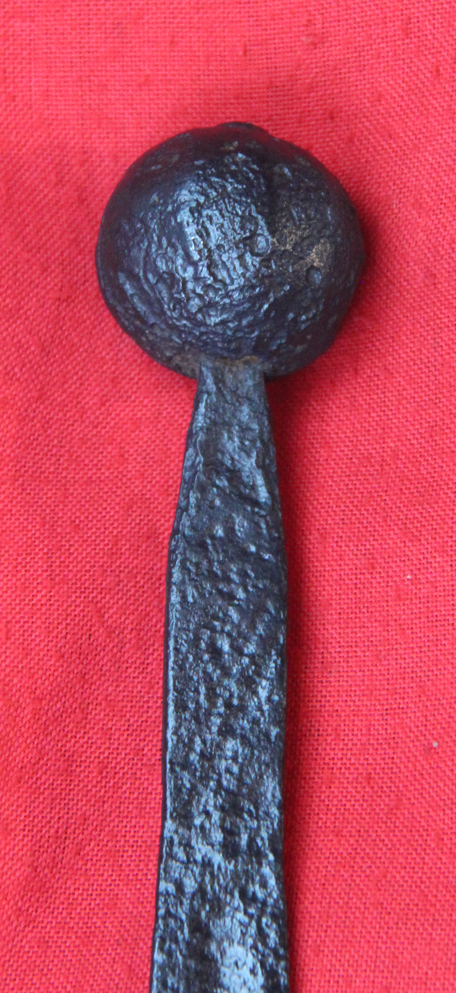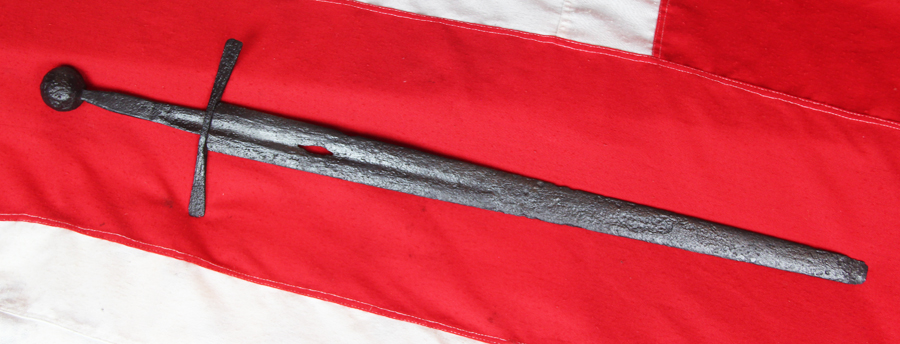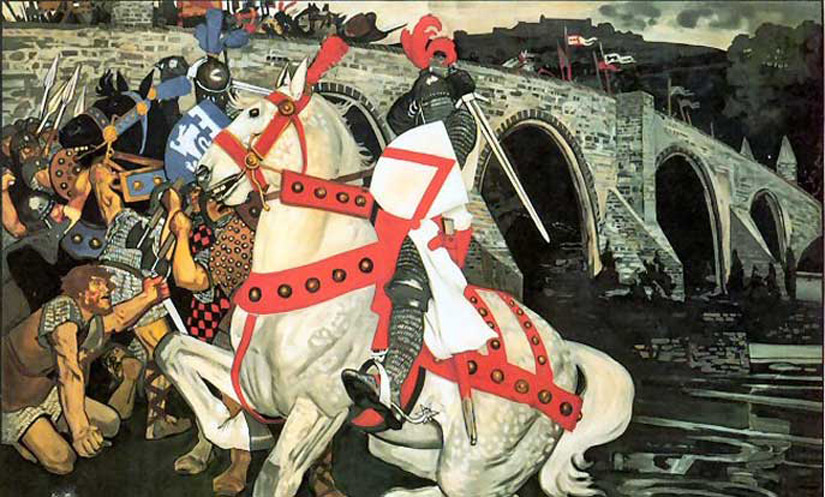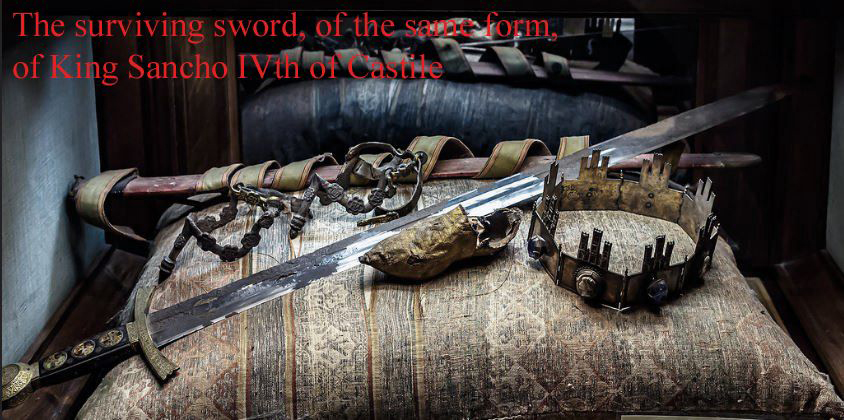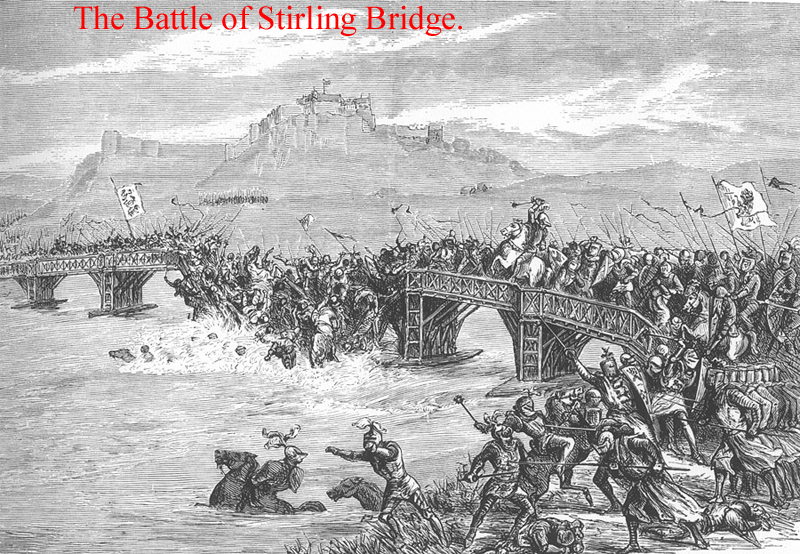A Museum Quality Original & Ancient, Crusades Period, King Edward Ist Medieval Knights Sword, 13th century. Used During The Time of Edward Longshanks, William Wallace and Robert The Bruce, Used By Both English & Scottish Knights During That Historic Era
The type known in academic circles as the Oakshott Type XII. What a fabulous original ‘statement piece’ for any collection or decor. In the world of collecting there is so little remaining in the world from this highly significant era in European and British history. And to be able to own and display such an iconic original representation from this time is nothing short of a remarkable privilege.
A wonderful example piece, from the ancient knightly age. Effectively, from this time of almost eight hundred years ago, from a collectors point of view, nothing else significant survives at all, only the odd small coin or very rarely seen, and almost impossible to own, carved statuary.A simply stunning historical original double-edged original knight's crusades period iron longsword of Oakeshott's Type XII (Oakeshott, 1991, p.105). Incredibly, still complete with its iron scabbard mount. Oakeshott is the standard that describes and by which defines Medieval swords, their types, and periods of use. The swords' broad, flat, evenly tapering blade is typical of specimens of its category, with the blade tending to widen below the hilt; incredibly the iron mouth of its original scabbard is also still present decorated with an openwork flower, but now in 2 pieces; the fuller is well defined, extending from below the guard for a little more than half of the blade's length;
This is the dominant style of knightly sword in use during the time of King Edward 1st of England Edward Longshanks such as in the first War with Scotland against Robert the Bruce and Sir William Wallace. The frequent myth is that the Scots mostly used the great sword Claymore, as seen in Braveheart, but the reality is very few of those were used, and even the so called William Wallace Claymore in the Wallace museum display in Stirlingshire, Scotland is iust an amalgam of various mixed sword parts, a Ship of Theseus of sorts.
The 'Great Seal of Robert The Bruce' shows him holding the very same type of sword.
This type was frequently made in Venice, by their great armourers, and many king's around all Europe had this form of sword. King Edward's sword, for example, was very similar to this sword, in its shape and form, but the king's sword would have been thinly coated with gold on the hilt. The Battle of Falkirk, (22 July 1298) was the initial Scottish victory over the English at the Battle of Stirling Bridge in 1297, but was soon avenged by Edward at the Battle of Falkirk. English rule was thus re-established over Scotland, forcing William Wallace to wage a lengthy guerrilla campaign until he was hunted down, betrayed, and eventually executed for treason in 1305. After the disaster of Stirling Bridge, King Edward I of England determined to crush the Scots once and for all. He headed north to invade the country in 1298, advancing with an army of around 2,500 mounted knights many using swords just as this one and 12,500 infantry, including large numbers of Welsh and English archers armed with longbows. In response, Wallace tried to avoid a pitched battle, because his own forces were smaller than the English, totalling around 1,000 mounted knights and 5,000 infantry. Wallace preferred to conduct guerrilla warfare against the invading army, but was eventually forced into battle at Falkirk.
On the morning of battle, Wallace formed his pikemen up into four schiltrons, hedgehog like circular formations of pikemen standing shoulder to shoulder with their pikes facing outward through an outer row of men in armour. The gaps between the schiltrons were filled with archers. The four schiltrons withstood the initial English cavalry and infantry attacks but then became vulnerable to steady fire from Edward?s longbowmen, the first time significant use had been made of this deadly weapon in battle. As the arrows poured down, supplemented by crossbow and slingshot, the schiltrons were soon broken up by the charging English cavalry. The Scots then fled into the neighbouring woods. Wallace escaped, although he lost many supporters. English losses, too, were high, testimony to the effectiveness of the schiltrons in battle.
Losses: English, 2,000 of 15,000; Scottish, 2,000 of 6,000. This sword's blade's cross-section, being of lenticular design, was originally from thirty to thirty-two inches long; the grip is a little longer than previous Oakshott type XI; the style of guard is short and straight, with a flattened cross-section at the edges; the pommel is a thick spherical piece, slightly flattened at the centre. Nice condition for age.
To see references on this sword see Oakeshott, J, R.E., The Archaeology of the weapons, London, 1960 (Woodbridge, 1999); Oakeshott, E. 'Records of the Medieval Sword', Woodbridge, 1991; Nicolle, D., 'Arms and Armour of the Crusading Era', 1050-1350, vol I,, London, 1999; Scalini, M., 'A bon droyt, spade di uomini liberi, cavalieri e santi', Milano, 2007.
Oakeshott considered this category of sword as one of the most difficult to interpret, because of the affinity of the hilt with the types X and XVI (Oakeshott, 1991, p.65). Characteristics are the noticeable taper blade, with acute point, and the grip quite short, never of hand-and-a-half length. The fuller is usually running for at least half of the length of the blade. The sword was the most typical chivalry weapon diffused in all the Europe, largely attested by archaeological finds and artefacts from historical collections. Among the most famous specimen of such sword we should remember the one of Sancho IV (El Bravo) of Castilla, died in 1295 AD see photo in the gallery, which show a slightly curved hilt, and a cross-guard also expanded at the edges (Nicolle, 1999, cat.391). Our sword finds a good parallel in a Venetian sword preserved in Padova Museum (inv. IG 321119, s. Scalini, 2007, pp.126-127, cat.19), realised by an unknown Italian craftsman. Many of these swords were taken as booty from the Muslims taken from the vanquished crusader knights initially and preserved until recent times in the Arsenal of the Imperial Palace in Istanbul. Such weapons were mainly of Venetian origin, with slightly broader blades than our specimen. Scalini has suggested that such swords could also have been employed during the XIII-XIV century by the Venetian infantry in the operations of the Aegean Sea against Muslims and Eastern Romans. If this is true, the importance of the weapon consists in its functional use, not only reserved to the European and British knights, but also army of the Venetian Republic. The early flat disc pommels appear in the Mediterranean Sea at the beginning of the 12th century (for similar pommels s. Oakeshott, 1991, p.69) and persist in use until the 15th century and even later, although with significant variations. In art and medieval iconography, the best samples of swords of XII types can be seen on the famous Bible of Maciejowski made in approximately 1250 (Nicolle, 1999, 49a-49 as). Many of the swords illustrated therein seem to indicate a full length fuller; this might seem to indicate a Type X. However, most of the illustrations feature far too much profile taper to be a true Type X. Given the period of the Bible's manufacture they are far more likely to indicate swords of Type XII design. There is also an Apocalypse in the library of Trinity College, Cambridge (Nicolle, 1999, 189a-b) that was made around twenty years earlier that features illustrations of the type. Many of the illustrations from the Royal Armouries Manuscript I.33 can be interpreted as being of type XII pattern. More specifically, the typology of our specimen is visible on the sculpture of a warrior in the Church of Saint Justyna in Padua, confirming again the Venetian origin of such swords.
"Most probably our specimen is from a battlefield or, most probably, a river find. Type XII (Oakeshott, 1960 (1999) p.206), is generally dated between about 1180 and 1320, It has a large blade, very similar in shape to the Ulfberht ones but generally with a more acute point, and a well-marked and slightly narrower fuller starting in the tang and running about halfway along the blade; this occasionally is of two or more grooves. The pommel is generally in the form of a thick disc, sometimes with the edges bevelled off, sometimes of the so-called "wheel" form. Its cross is generally straight, circular in section and widening at the ends, but it may be of a square section; or it may be curved or have decorated terminals. Inscriptions on examples of these swords dating after about 1220 are slightly different again; the letters are closer together, often so dose that it is nearly impossible to make them out; and instead of the clearly legible religious phrase there is a jumble of repetitive letters which seems meaningless. Typical of the High Middle Ages, these swords begin to show greater tapering of the blade and a shortened fuller, features which improve thrusting capabilities while maintaining a good cut. The Cawood sword is an exceptionally well preserved type XII specimen, exemplifying a full-length taper and narrow fuller, which terminates two thirds down the blade. A number of Medieval examples of this type survive. It certainly existed in the later 13th century, and perhaps considerably earlier, since the Swiss National Museum in Zurich possesses an example that has a Viking Age-type hilt but clearly a type XII blade." Above quote on this sword from Dr Raffaele D'Amato. Small hole damage to central fuller and extreme tip missing. As with all our items they are accompanied with a Certificate of Authenticity and thus Guaranteed for Life. Just under a kilo in weight, 74.5cm (29 1/4" inches long overall). As usual the wooden handle and scabbard leather perished centuries past. Almost every iron weapon that has survived today from this era is now in a fully russetted condition, as is this one, because only the swords of kings, that have been preserved in national or Royal collections are today still in a good state and condition. This sword will be accompanied by a complimentary wooden display stand. It could also be enhanced by affixing to a rectangular bespoke display panel.
Every single item from The Lanes Armoury is accompanied by our unique Certificate of Authenticity. Part of our continued dedication to maintain the standards forged by us over the past 100 years of trading
Code: 22938
11275.00 GBP


